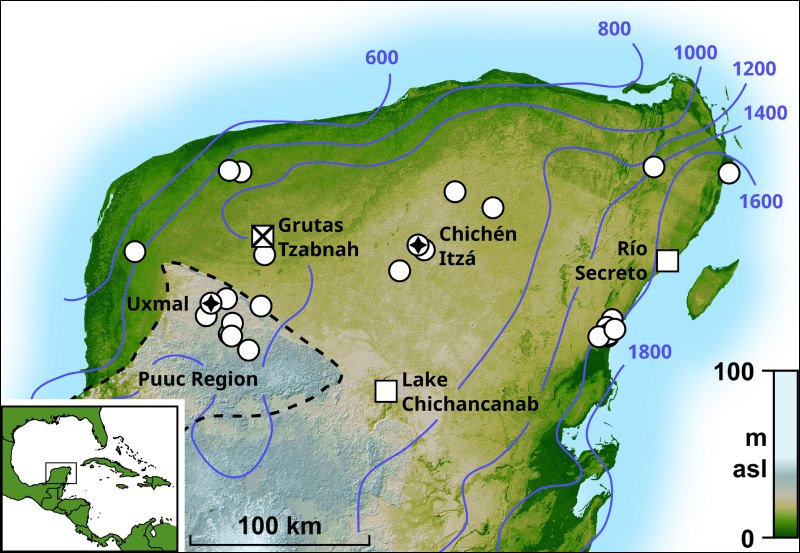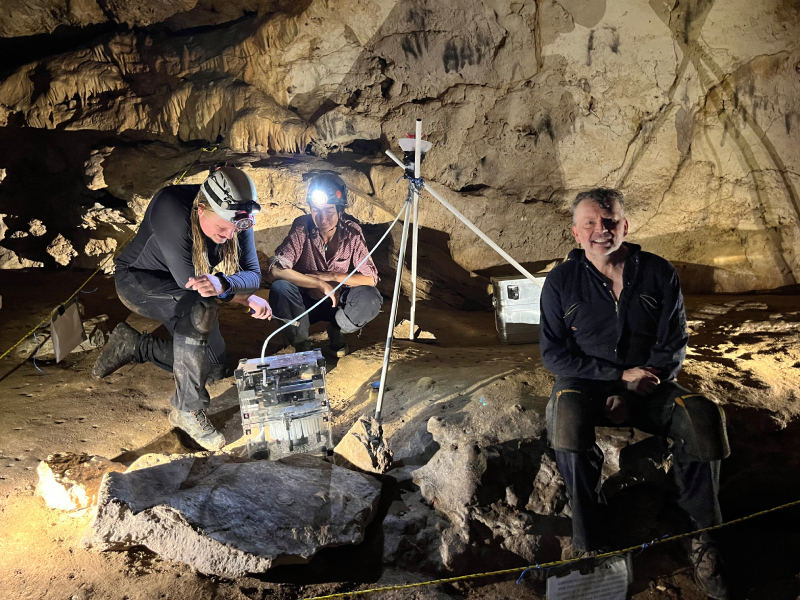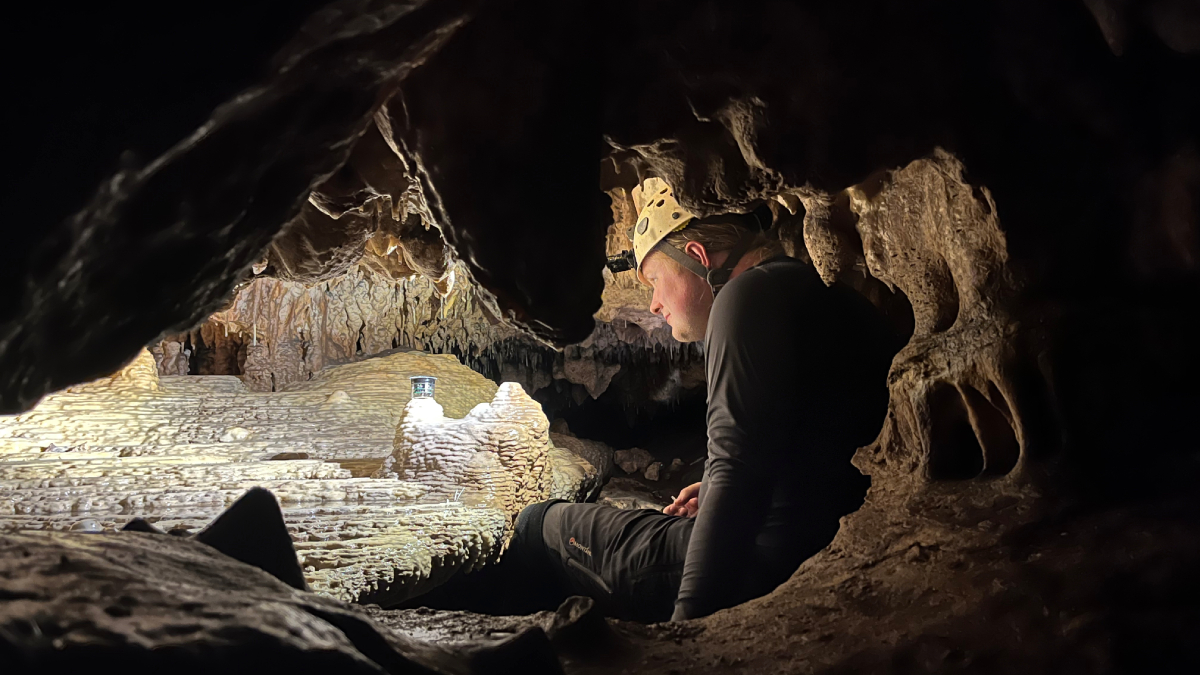A stalagmite in a Yucatán cave has provided new insight into the role drought may have played in Maya sociopolitical shifts more than 1,000 years ago. A recent analysis of a rainfall proxy in the Maya lowlands revealed that several episodes of severe, prolonged drought occurred during the Maya Terminal Classic Period (roughly 800–1000 CE), a time when large urban centers experienced major sociopolitical shifts.
The researchers suggest that just as climate change acts as a threat multiplier today, drought may have amplified existing troubles in Maya political centers like Chichén Itzá and Uxmal and added climate stress to societies already under pressure.
“These climate events would have affected each individual site in a very specific way depending on the resilience of that site at that time,” said lead researcher Daniel James, who studies paleoenvironmental reconstruction at University College London. “Hopefully the precision of this record allows that [analysis] to be done at individual sites…then we can really start to build up a picture of what I am certain will be a wide variety of societal responses to climate change across this time and across the region.”
Extended Droughts During Wet Seasons
During the Maya Terminal Classic Period, several Maya city-states in the southern lowlands (in modern-day Mexico, Belize, and Guatemala) experienced sociopolitical upheaval, site abandonment, and depopulation. Political and cultural centers shifted northward. Although the societal changes are clear in the archaeological record, there is still widespread debate about the potential drivers of these shifts as well as why some city-states survived while others did not.

Drought comes up often in these debates as a potential destabilizer: Insufficient or unpredictable rainfall can lead to food instabilities, trade disruptions, disease, and even military conflicts. But previous paleoclimate studies failed to precisely pin down the timings and durations of droughts in the Maya lowlands during the Terminal Classic Period, James said.
James and his colleagues trekked to a cave called Grutas Tzabnah, in the state of Yucatán, Mexico, located near several large Classic Maya sites, including Chichén Itzá and Uxmal. This cave has been sought out before for paleoclimate studies of the region because of its accessibility and well-preserved cave formations. What’s more, Grutas Tzabnah is also a relatively shallow cave, which means that water does not take long to drip into the cave from ground level.
The researchers chose a stalagmite that has been growing for thousands of years and shows distinct annual growth layers. This particular stalagmite grew fast in the layers that dated back to the Maya Terminal Classic Period, James said, so the team was able to collect 10–20 data points within each annual layer to determine subannual, seasonal rainfall.

“You can see wet seasons and dry seasons in our record, whereas previous records from the same cave are looking at annual average rainfall,” James said. “Wet season rainfall is what determines the success or failure of agriculture, as opposed to annual average.”
They measured the ages of the layers using uranium-thorium radiometric dating and rainfall quantity using a stable oxygen isotope ratio, δ18O, within calcite. Stalagmite samples that recorded a lower δ18O indicate more rainfall, while higher δ18O indicates less rainfall. The team calibrated their paleoclimate calculations with modern rainwater and cave drip measurements over a few years to ensure that they could convert the stalagmite’s δ18O measurements to rainfall.
From 871 to 1021, the stalagmite recorded eight extreme droughts during wet seasons, each lasting at least 3 years. A 4-year drought that started in 894 was interrupted by a single wet year and was followed by another 5 years of wet-season drought. A few decades later, the region had experienced 13 consecutive years of wet-season drought (929–942), longer than any multiyear drought in local historical records. This research was published in Science Advances in August.
“The chronology makes this one of the most detailed paleoclimate records available for understanding human-climate interactions during the Maya collapse period.”
“This new study represents a significant advancement in our understanding of Terminal Classic drought patterns, primarily due to its exceptional temporal resolution and robust age control with uncertainties of just a few years,” said Sophie Warken, who studies speleothems and climate variability at Universität Heidelberg in Germany and was not involved with this research.
“This high-resolution approach enables the authors to examine the timing and duration of individual drought episodes very precisely, which previous studies could only identify as broad periods of drying,” Warken added. “The chronology makes this one of the most detailed paleoclimate records available for understanding human-climate interactions during the Maya collapse period.”
One Piece of the Puzzle
While this rainfall record is a big step forward, Warken said that she would like to see it verified using additional proxies like trace elements, as well as a longer modern calibration period. She would also like to see this record extended to before and after the Terminal Classic Period to gauge whether those droughts were truly exceptional for the region.
“Such expanded paleoclimate networks could also provide crucial baselines for assessing recent and future climate changes in this vulnerable region,” she added.
Despite the fact that the extended droughts coincide with major societal shifts, James cautioned that this does not mean that drought caused these changes or were even the most important factor.
“I would love for this data to be used to pick apart individual stories from individual sites of resilience and survival, as well as the stories of disintegration of systems and abandonment and loss of population.”
“Other hardships like famine, disease, and internal violence could have been caused by drought or indeed could have been ongoing beforehand and made the society more susceptible to and less prepared for climate hardship,” James said.
Importantly, archaeological evidence suggests that two Maya cities near this cave, Chichén Itzá and the regional capital of Uxmal, did not decline at the same rate. (Uxmal declined much more rapidly.) Understanding the pressures that the two cities experienced, including drought, will be key to creating a holistic picture of how the cities functioned during the Terminal Classic Period.
“While climate stress likely played an important role in the Terminal Classic transformations,” Warken said, “the Maya’s response to drought was probably mediated by existing social, political, and economic vulnerabilities that varied between different centers and regions.”
“It could be how well were they ruled, how rigid or flexible was their political system, how good was their water management at the time,” James said.
“I would love for this data to be used to pick apart individual stories from individual sites of resilience and survival, as well as the stories of disintegration of systems and abandonment and loss of population,” he added.
—Kimberly M. S. Cartier (@astrokimcartier.bsky.social), Staff Writer

